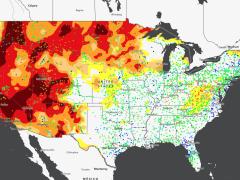New Study Models Users’ Trust in Drought Forecasts
Effective use of drought forecasts is critical for farmers to make proactive, well-informed decisions. Forecasts are especially important in rainfed agriculture, since without irrigation, little can be done to protect against droughts once a crop is planted. A key factor that determines how decision makers respond to and use drought forecasts is the extent to which they trust those forecasts. However, modeling studies of forecast valuation have rarely considered the role of user trust in a forecast’s value.
To help integrate user trust into forecast valuation, a new NIDIS-funded study proposes a framework to model trust in drought forecast information that captures how users’ trust forms and evolves over time and shows how trust influences users’ decisions. In the study, published in Weather, Climate, and Society, researchers from the University of Illinois-Urbana Champaign and the University of Virginia found that users’ trust in drought forecasts significantly influences the way the information is integrated with their prior knowledge.
The authors applied their proposed framework to a crop-allocation decision problem, where users receive a drought forecast for the crop season and decide the best allocation between two crops with different yield and drought tolerance. Through this framework, the researchers provided a description of what farmers in rainfed agricultural systems, particularly in the Midwestern U.S., could potentially do in response to seasonal drought forecasts.
Results show that encouraging users to rely on poor forecasts can make them worse off, potentially deterring them from using forecasts in the future. But the research team found that even if users are exposed to relatively accurate forecasts, they may not use this information immediately because a minimum level of trust must be developed before forecasts are perceived to be valuable and integrated into decision making.
But how long does it take for the trust to develop? The researchers modeled how a user builds up trust as more information about the forecasting systems is accumulated over time. In a numerical experiment, the time lag for trust to develop was relatively short. However, even a short time lag could delay the effective use of potentially valuable forecasts, particularly in the critical first stage of exposure to a new technology. This raises the question of what strategies should be employed to facilitate and accelerate the use of forecasts. One potential solution is to design incentive mechanisms or to target opinion leaders to encourage the use of forecasts in user communities.
This research was funded by NIDIS through NOAA’s Climate Program Office 2018 Coping with Drought research competition. Learn more about this research.





